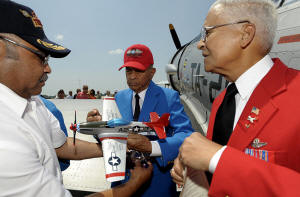Decorated pilot Harry Stewart, Jr., one of the last surviving Tuskegee
Airmen, dies at 100
 Send a link to a friend
Send a link to a friend
 [February 05, 2025]
By KIM CHANDLER [February 05, 2025]
By KIM CHANDLER
Retired Lt. Col. Harry Stewart Jr, a decorated World War II pilot who
broke racial barriers as a Tuskegee Airmen and earned honors for his
combat heroism, has died. He was 100.
Stewart was one of the last surviving combat pilots of the famed 332nd
Fighter Group also known as the Tuskegee Airmen. The group were the
nation’s first Black military pilots.
The Tuskegee Airmen National Historical Museum confirmed his death. The
organization said he passed peacefully at his home in Bloomfield Hills,
Michigan, on Sunday.
Stewart earned the Distinguished Flying Cross for downing three German
aircraft during a dogfight on April 1, 1945. He was also part of a team
of four Tuskegee Airmen who won the U.S. Air Force Top Gun flying
competition in 1949, although their accomplishment would not be
recognized until decades later.
“Harry Stewart was a kind man of profound character and accomplishment
with a distinguished career of service he continued long after fighting
for our country in World War II,” Brian Smith, president and CEO of the
Tuskegee Airmen National Historical Museum, said.
Born on July 4, 1924, in Virginia, his family moved to New York when he
was young. Stewart had dreamed of flying since he was a child when he
would watch planes at LaGuardia airport, according to a book about his
life titled “Soaring to Glory: A Tuskegee Airmen’s Firsthand Account of
World War II.” In the wake of Pearl Harbor, an 18-year-old Stewart
joined what was then considered an experiment to train Black military
pilots. The unit sometimes was also known as the Tuskegee Airmen for
where they trained in Alabama or the Red Tails because of the red tips
of their P-51 Mustangs.
“I did not recognize at the time the gravity of what we are facing. I
just felt as though it was a duty of mine at the time. I just stood up
to my duty,” Stewart said of World War II in a 2024 interview with CNN
about the war.
Having grown up in a multicultural neighborhood, the segregation and
prejudice of the Jim Crow-era South came as a shock to Stewart, but he
was determined to finish and earn his wings according to the book about
his life. After finishing training, the pilots were assigned to escort
U.S. bombers in Europe. The Tuskegee Airmen are credited with losing
significantly fewer escorted bombers than other fighter groups.
[to top of second column]
|

Tuskegee Airmen Detroit Chapter President Arthur Green, left, of
Farmington Hills, holds a P-51 D model plane as Lt. Col. Harry
Stewart, Jr., center, and Col. Charles McGee, right sign their
autographs on the model for the 127th Mission Support Group, June
19, 2012, at Selfridge Air National Guard Base. (Todd McInturf/Detroit
News via AP, File)

“I got to really enjoy the idea of the panorama, I would say, of the
scene I would see before me with the hundreds of bombers and the
hundreds of fighter planes up there and all of them pulling the
condensation trails, and it was just the ballet in the sky and a
feeling of belonging to something that was really big,” Stewart said
in a 2020 interview with WAMC.
Stewart would sometimes say in a self-effacing way that he was too
busy enjoying flying to realize he was making history, according to
his book.
Stewart had hoped to become a commercial airline pilot after he left
the military, but was rejected because of his race. He went on to
earn a mechanical engineering degree New York University. He
relocated to Detroit and retired as vice president of a natural gas
pipeline company.

Stewart told Michigan Public Radio in 2019 that he was moved to
tears on a recent commercial flight when he saw who was piloting the
aircraft.
“When I entered the plane, I looked into the cockpit there and there
were two African American pilots. One was the co-pilot, and one was
the pilot. But not only that, the thing that started bringing the
tears to my eyes is that they were both female,” Stewart said.
The Air Force last month briefly removed training course s with
videos of its storied Tuskegee Airmen and the Women Airforce Service
Pilots, or WASPs in an effort to comply with the Trump
administration’s crackdown on diversity, equity and inclusion
initiatives. The materials were quickly restored following a
bipartisan backlash.
All contents © copyright 2025 Associated Press. All rights reserved |